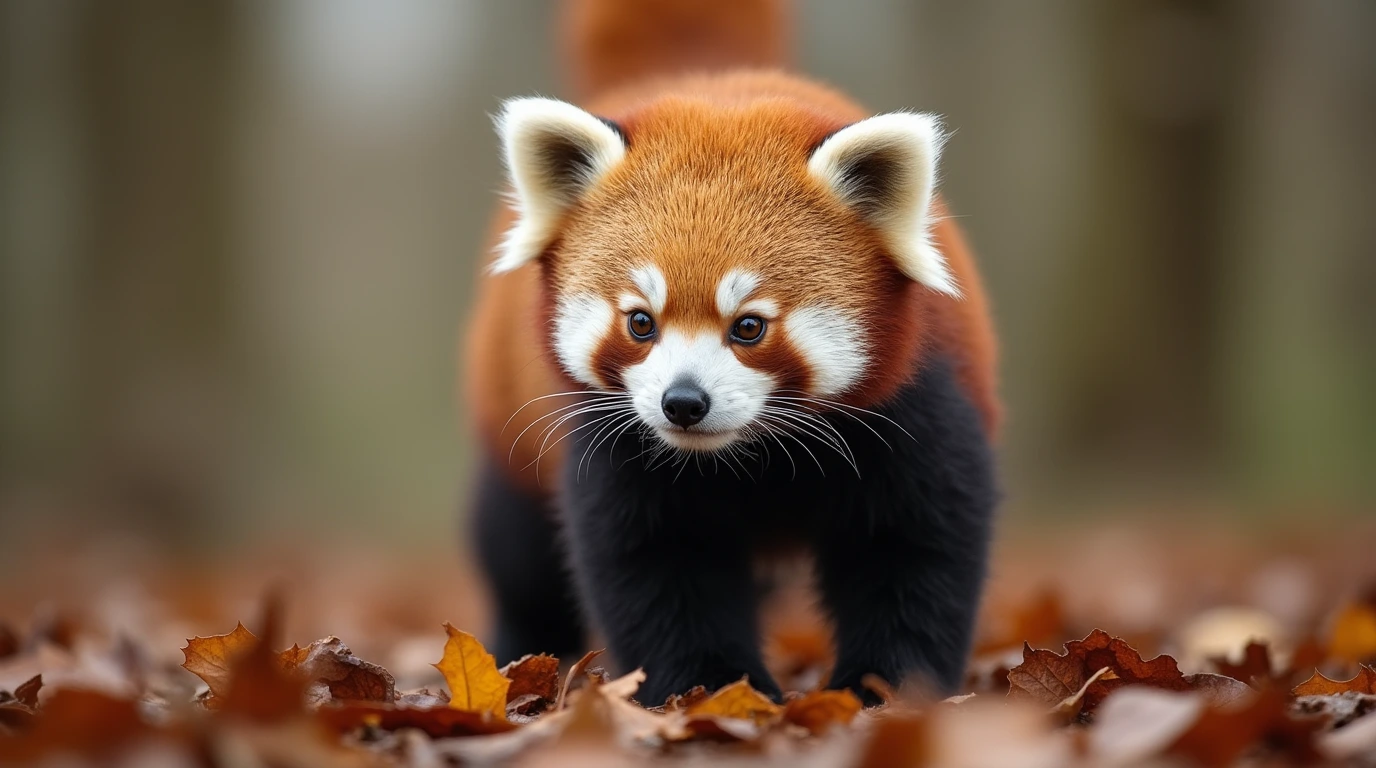Red pandas may appear small and defenseless, but they have evolved effective survival strategies to handle threats in their environment. Living in the dense forests of the Himalayas and China, they must defend themselves against natural predators, human encroachment, and habitat loss. Their response to danger depends on the situation—sometimes they flee by climbing trees, while other times they rely on intimidation displays, sharp claws, and vocal warnings to deter threats
In this article, we will explore how red pandas respond to potential threats in their environment, examining their main predators, escape tactics, defensive behaviors, and adaptive strategies. We will also discuss the impact of human-related threats such as deforestation and climate change, highlighting conservation efforts that help protect these vulnerable animals
How Do Red Pandas React To Potential Dangers

Despite their small size and solitary nature, red pandas have developed effective defense mechanisms to survive in the wild. They face threats from natural predators, territorial disputes, and human activities, and their response depends on the type of danger they encounter. Whether using agility, vocal warnings, or defensive postures, red pandas rely on their instincts to avoid harm while maintaining their secretive lifestyle
Main Predators of Red Pandas
In their native habitats across the eastern Himalayas and southwestern China, red pandas must stay alert to potential predators. One of their most formidable natural enemies is the snow leopard, a stealthy and powerful predator that can stalk and ambush red pandas in the forests where they live. Snow leopards, being excellent climbers, pose a significant threat since they can pursue red pandas even in elevated areas
Another major predator is the yellow-throated marten, a highly agile and opportunistic hunter that preys primarily on young red panda cubs. Since cubs spend their early weeks in tree hollows, they are particularly vulnerable to attacks from martens, which can climb and access dens. Other predators include jackals and birds of prey, which may target smaller or weaker red pandas when given the opportunity
Although adult red pandas are difficult for most predators to capture due to their climbing ability and camouflage, young and inexperienced individuals are at much greater risk. This is why red pandas rely heavily on avoidance strategies, including tree-dwelling behavior and nesting in concealed locations
How Climbing Helps Red Pandas Escape Danger
Red pandas are arboreal animals, meaning they spend much of their time in trees. This skill is not just useful for foraging—it is also their primary escape strategy when confronted with a predator. Their sharp, curved claws allow them to grip bark securely, and their flexible ankles enable them to climb down headfirst, an ability that gives them an advantage when evading threats
When sensing danger, a red panda will instinctively climb the nearest tree, sometimes ascending to high, dense canopies where predators cannot follow. They often remain completely still, blending into their surroundings to avoid detection. This behavior is particularly effective against ground-based predators, such as jackals and stray dogs, which are unable to pursue them into the trees
Young red pandas learn this skill early from their mothers, as they must be able to climb independently by the time they leave the nest at around three months old. Cubs that master climbing quickly have a much higher chance of survival, as they can escape potential threats before being detected
Defensive Behaviors When Red Pandas Are Cornered
If a red panda is unable to escape by climbing, it will switch to a defensive stance to intimidate the threat. One of the most well-known behaviors is its ability to stand on its hind legs, raising its front paws to appear larger and more threatening. This is meant to discourage predators from attacking, as a larger-looking animal may seem more difficult to overpower
In addition to visual intimidation, red pandas will swipe with their sharp claws if a predator or rival gets too close. While their claws are primarily adapted for climbing, they can still be used to scratch and wound attackers if necessary. If the threat persists, red pandas may also attempt to bite, using their strong jaw and sharp teeth, which are designed for chewing bamboo but can still deliver a painful defensive strike
Despite these defensive capabilities, red pandas prefer avoidance over confrontation. They rely on their ability to flee, hide, and intimidate rather than fight, minimizing their risk of injury. Only when escape is not an option do they resort to direct physical defense
For further details on how red pandas use climbing and defensive behaviors to protect themselves, you can explore the Red Panda Network’s article on red panda survival strategies, which highlights their adaptive responses to danger
Communication and Behavioral Adaptations

In addition to physical escape tactics, red pandas rely on vocalizations and adaptive behaviors to avoid or deter threats. Their ability to adjust their responses based on different dangers allows them to navigate a variety of environmental risks while maintaining their solitary lifestyle
How Red Pandas Use Vocalizations to Warn Off Predators
Although red pandas are usually quiet animals, they become vocal when confronted with a threat. One of their most commonly used alarm signals is a sharp bark, which serves as an immediate warning to nearby red pandas or a potential predator. This short, loud sound signals distress and may be enough to startle an approaching animal, giving the red panda time to escape
If the threat persists, red pandas escalate their vocalizations, producing low growls and huffing sounds, sometimes combined with jaw-clapping, a behavior where they rapidly snap their jaws to create a loud noise. These sounds are intended to intimidate and deter an approaching predator without engaging in direct combat
In extreme cases, red pandas may hiss while flattening their ears and raising their fur. This is a final warning sign that they feel cornered and may resort to defensive swipes or bites if provoked. Cubs also use vocalizations for protection, emitting high-pitched squeals to alert their mother when they sense danger. These vocal signals allow red pandas to communicate their distress without needing prolonged interactions, helping them minimize the risks associated with confrontation
Adaptive Responses to Different Threats
Red pandas have developed flexible survival strategies, allowing them to respond differently depending on the type of danger they face. When encountering a ground-based predator, such as a jackal or a feral dog, their first instinct is to climb to safety, using the dense tree canopy to remain hidden. If an aerial predator, such as a hawk or an owl, is nearby, they may instead choose to freeze in place, relying on their reddish-brown fur to blend into the surrounding foliage
When dealing with a rival red panda, such as during territorial disputes in mating season, their response is different. Instead of running or hiding, they use jaw-clapping, tail-flicking, and defensive posturing to establish dominance. This allows them to avoid unnecessary fights while reinforcing their boundaries
In areas where red pandas experience human disturbances, such as poaching or habitat destruction, they may alter their daily habits to become more nocturnal, reducing their chances of encountering humans. This shift in behavior demonstrates their ability to adapt to changing threats over time
How Red Panda Cubs Stay Safe from Predators
Young red panda cubs are particularly vulnerable to predation, as they are born blind and defenseless in tree hollows or rock crevices. Their survival depends entirely on their mother’s ability to protect and conceal them from threats. To reduce the risk of predators detecting her cubs, the mother moves them between multiple nest sites, ensuring that no single location carries a strong scent trail
Cubs also rely on instinctual stillness as a defense mechanism. When sensing a nearby predator, they remain completely silent and motionless, making it more difficult for an attacker to locate them. As they grow older and begin exploring their surroundings, they quickly develop climbing skills, allowing them to reach safety if a predator is detected
By the time cubs are six to eight months old, they are strong enough to climb independently, reducing their reliance on their mother for protection. At around one year old, they leave their mother’s territory to establish their own home range, at which point they rely on the same escape tactics and defensive behaviors as adult red pandas
For more details on how red pandas communicate and adapt their behavior to threats, you can explore the IFAW’s research on red panda defense mechanisms, which provides insights into their survival strategies
Environmental Challenges and Conservation

While red pandas have evolved effective strategies to evade predators, human-induced threats such as habitat destruction, climate change, and poaching have dramatically increased their vulnerability. Unlike natural predators, these threats cannot be avoided through climbing or defensive posturing, requiring conservation efforts to ensure their survival
The Impact of Habitat Loss on Red Panda Survival
Deforestation is one of the biggest challenges red pandas face. As human activities such as logging, agriculture, and infrastructure development expand, the dense forests they rely on for shelter and escape routes are rapidly disappearing. Without tall trees to retreat to, red pandas lose their primary defense mechanism, making them more vulnerable to ground-based predators like feral dogs and jackals
Habitat fragmentation further isolates red panda populations, forcing them to travel greater distances in search of food and shelter. This increased movement puts them at higher risk of encounters with predators, poachers, and roads, significantly reducing their chances of survival. In some areas, red pandas have been observed altering their activity patterns, becoming more nocturnal to avoid human disturbances. However, this adaptation does not fully compensate for the loss of their natural habitat
Human Threats and Their Effect on Red Panda Behavior
In addition to habitat destruction, red pandas face direct threats from poaching, the illegal pet trade, and climate change. Despite legal protections in many regions, red pandas are still hunted for their fur and captured for sale as exotic pets, reducing wild populations and disrupting their natural behaviors
Another growing concern is the impact of feral and domestic dogs, which not only prey on red pandas but also introduce diseases such as canine distemper, which has been linked to population declines in some areas. Since red pandas are highly susceptible to infections, exposure to human-associated diseases poses a significant risk to their long-term survival
Climate change also affects red panda habitats by altering bamboo growth cycles, their primary food source. Warmer temperatures and shifting rainfall patterns can reduce bamboo availability, forcing red pandas to travel longer distances for food, which increases their risk of predation and human encounters
Conservation Efforts to Protect Red Pandas from Predators
Recognizing these threats, conservation groups have launched multiple initiatives to protect red pandas and mitigate the risks they face. One of the most important strategies is habitat preservation, with organizations working to establish protected areas and wildlife corridors that allow red pandas to move safely between forest patches without crossing human-dominated landscapes
Anti-poaching programs and stricter law enforcement aim to reduce illegal hunting, while conservationists are working with local communities to reduce conflicts between red pandas and domestic animals, particularly by managing feral dog populations and vaccinating domestic dogs against diseases that could spread to wildlife
Educational campaigns are also essential in raising awareness about red panda conservation, encouraging local populations to support sustainable practices that protect their forests. Eco-tourism initiatives, such as guided red panda tracking experiences, provide financial incentives for conservation while promoting ethical wildlife observation
For further insights into how conservationists are addressing environmental threats to red pandas, you can explore the NOAA Fisheries report on habitat loss and wildlife threats, which discusses broader ecological challenges affecting vulnerable species













